Emblems for mobility
with luminescence plus radar transparency
- HOME
- Areas of focus
- Emblems for mobility with luminescence plus radar transparency
The automobile industry is transforming with advances in vehicle electrification and autonomous driving, as well as the growing need for measures to combat climate change. During this time of change, Toyoda Gosei has succeeded in developing emblems that provide both luminescence and transparency to millimeter wave radar. These emblems not only contribute to detection of the surroundings and safety during driving, but also to an increased degree of freedom in vehicle front design.
01Development of new materials that provide both luminescence and radar transparency
Achieving both luminescence and radar transparency was considered difficult with the substrate used in existing millimeter wave radar compatible emblems. With its materials technology, however, Toyoda Gosei focused on plastic materials that are transparent to both light and radar. By blending various material ingredients, the company created new materials that can satisfy customer needs for rigidity, impact resistance, transparency, light diffusion, color tone and more. Repeated testing through various types of assessments has led to the adoption of these new materials.
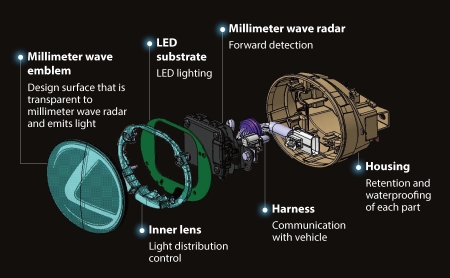
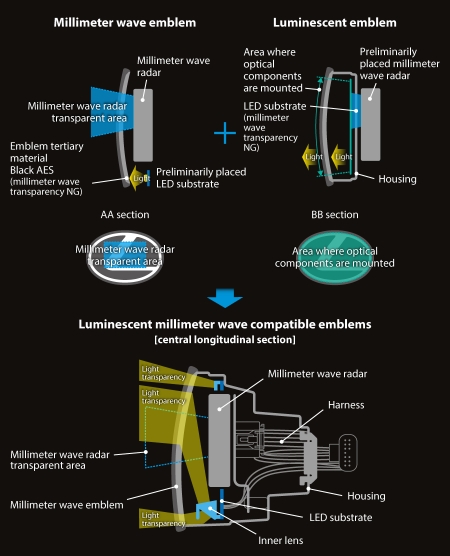
02Optical design for uniform luminance
In ordinary luminescent emblems, LED substrates are placed just behind the emblem, but to allow radar to pass through Toyoda Gosei needed to make a donut shape with a hole in the central portion of the LED substrate. Even with these donut-shaped substrates, it is the optical design of the inner lens that enables uniform luminescence of the emblem. A unique shape has been adopted to control light, including a bowl shape that focuses the incoming LED light and a top plate above the reflective surface. The surface is also textured, with a fine waveform and unevenness in some parts. These things serve the roles of diffusing light and preventing light leakage. This rigorous optical design is supported by simulation technology with computer-aided engineering (CAE). The emblems are divided into three areas (upper outer circumference, lower outer circumference, L shape), and we attempt to optimize each while fully employing CAE.
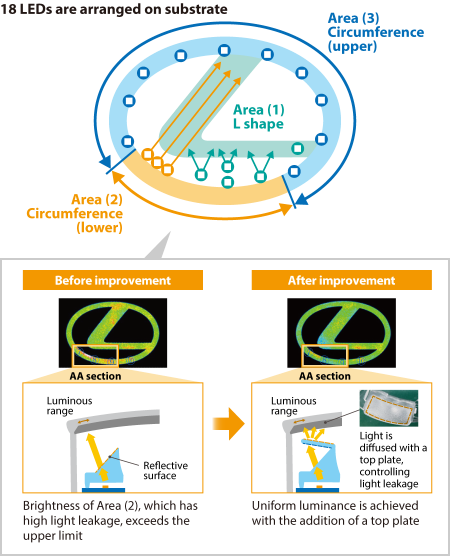
03Optimum surface design in a limited space
The surface of the donut-shaped LED substrate is three-fourths the size that of previous luminescent emblems. More than 150 electronic components are placed in these small areas, including pea-sized condensers, LED chips, and transistors. To dissipate heat uniformly over the entire surface, more than 1,000 dot-shaped conductivity through-holes penetrate the surface.
The circuit that connects these LED chips in parallel is susceptible to noise as it becomes longer (radio interference from mobile phones, radios and more), and so modifications are made to connect them in the shortest distance. Here as well, CAE is used to derive the optimum circuit through repeated testing of light and heat dissipation.
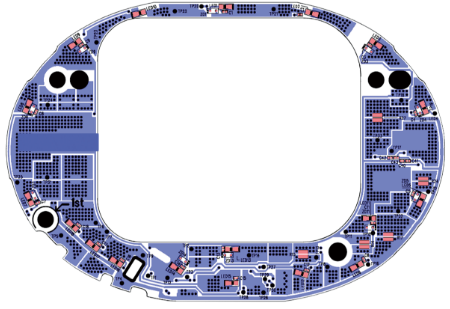
LED substrate with a special shape with through-holes in the center
04Contributing to the future evolution of automobiles
The technology established in developing these products is promising not only for emblems but also for use in other areas of automobile bodies. For example, technology for luminescence and radar transparency in these body regions will play an important role in communication functions that use light and sensing functions, for which needs will increase with autonomous driving. Autonomous driving and electrification will lead to a huge transformation in the front area of vehicles, and technology that provides both design and functionality will provide new freedom for the vehicle front.
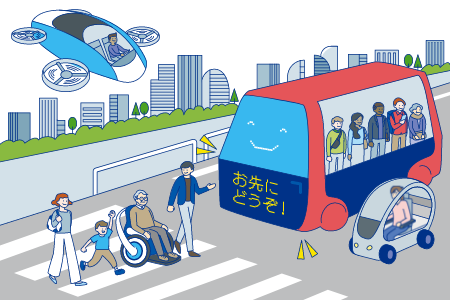
Voice of developers
We want to anticipate future customer needs and contribute to the evolution of automobiles
With the thought that emblems that provide both luminescence and radar transparency would become necessary at some point, we began development about four years ago. That’s why we were able to reach the stage of mass production in the short time of about two years. Radar-transparent emblems are used in many domestically-produced automobiles, excluding certain automakers and mini vehicles. If these emblems are upgraded to have a luminescent function, the market will be huge. We will continue to be proactive in development, anticipating the needs of end users and automakers.
Hirotaka Fukui, General Manager, EM Engineering Division

